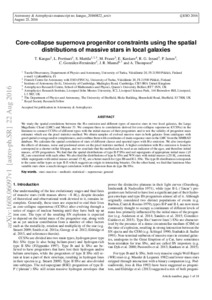Core-collapse supernova progenitor constraints using the spatial distributions of massive stars in local galaxies
Kangas T.; Portinari L.; Mattila S.; Fraser M.; Kankare E.; Izzard R. G.; James P.; González-Fernández C.; Maund J. R.; Thompson A.
https://urn.fi/URN:NBN:fi-fe2021042715946
Tiivistelmä
We study the spatial correlations between the H$alpha$ emission and different types of massive stars in two local galaxies, the Large Magellanic Cloud (LMC) and Messier 33. We compare these to correlations derived for core-collapse supernovae (CCSNe) in the literature to connect CCSNe of different types with the initial masses of their progenitors and to test the validity of progenitor mass estimates which use the pixel statistics method. We obtain samples of evolved massive stars in both galaxies from catalogues with good spatial coverage and/or completeness, and combine them with coordinates of main-sequence stars in the LMC from the SIMBAD database. We calculate the spatial correlation of stars of different classes and spectral types with H$alpha$ emission. We also investigate the effects of distance, noise and positional errors on the pixel statistics method. A higher correlation with H$alpha$ emission is found to correspond to a shorter stellar lifespan, and we conclude that the method can be used as an indicator of the ages, and therefore initial masses, of SN progenitors. We find that the spatial distributions of type II-P SNe and red supergiants of appropriate initial mass ($gtrsim$9 $M_{odot}$) are consistent with each other. We also find the distributions of type Ic SNe and WN stars with initial masses $gtrsim$20 $M_{odot}$ consistent, while supergiants with initial masses around 15 $M_{odot}$ are a better match for type IIb and II-L SNe. The type Ib distribution corresponds to the same stellar types as type II-P, which suggests an origin in interacting binaries. On the other hand, we find that luminous blue variable stars show a much stronger correlation with H$alpha$ emission than do type IIn SNe.
Kokoelmat
- Rinnakkaistallenteet [27094]
